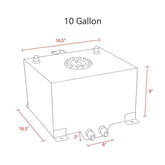What Is a Catalytic Converter?
When cars are operating, they produce a lot of emissions, which are gases and fumes. Because emissions are a contributing factor to air pollution, the United States created the Clean Air Act in 1963 in an effort to lessen the pollution that various businesses produced.
The first federal vehicle emissions requirements were established by the National Emissions requirements Act, a 1965 addition to the Clean Air Act. Every state follows federal restrictions, and several mandate testing of all registered vehicles to determine their emissions output.
A variety of components in today's exhaust systems help reduce pollutants and make cars more ecologically friendly. A catalytic converter is one of these components, and it assisted numerous automakers in meeting the National Emissions Standards Act's requirements.
A catalytic converter is a crucial component of an automobile's exhaust system, as was previously noted. It reduces the amount of airborne toxic pollutants by transforming dangerous combustion gases into less dangerous ones, such as carbon dioxide and water vapor.
In order to achieve this, these fumes are exposed to metals and chemicals inside the converter, which causes chemical reactions that change otherwise hazardous pollutants into ones that are comparatively safe. Let's take a closer look at how a catalytic converter works.
Why do cars need a catalytic converter?
When car exhaust is released into the atmosphere, it releases harmful fumes that harm the ecosystem and result in smog and acid rain.
These pollutants are chiefly:
- Hydrocarbons
- Carbon monoxide
- Nitrogen oxides
Car makers have been looking for innovative ways to lower the amount of pollutants that come from moving cars since the 1950s.
The catalytic converter was invented in 1975, and it is currently the most crucial component of an automobile's emission control system.
In order to fulfill European emissions requirements, all petrol cars built in the UK were required by legislation to have a catalytic converter installed on the exhaust in 1993.
Diesel particulate filter (DPF) installed in modern diesel vehicles.
This performs functions comparable to a catalytic converter, however it eliminates more soot and particulates.
How Do Catalytic Converters Work?
What then makes up a catalytic converter? A catalytic converter's catalyst is usually constructed of platinum or a similar metal, such palladium or rhodium. Within the cat housing, there is a ceramic honeycomb structure through which gases pass. This is lined with metals that each have a specialized function that helps lower pollutants. There are two primary categories of catalysts that can be found in automobiles:
Reduction catalysts: By taking out oxygen, they aid in lowering nitrogen oxide emissions. Nitrogen and oxygen gases, which are safe on their own, are produced when nitrogen oxides are broken down.
Oxidation catalysts: These devices use the reverse process of supplying oxygen to convert carbon monoxide into carbon dioxide.
An oxygen (O2) sensor, which measures the amount of oxygen in exhaust gases and relays that information to the vehicle's electronic control unit (ECU), is also situated next to the catalytic converter. This facilitates a more efficient air/fuel ratio in the vehicle, enabling the engine to provide the converter with sufficient oxygen to finish the oxidation process.
Catalytic Converter Types
There may or may not be a reduction catalyst installed in a car, depending on the year and kind of catalytic converter. Catalytic converters are primarily divided into two types:
Two-way: The two-way catalytic converter was present on vehicles in the United States until 1981.Their only available catalysts are oxidation ones, which aid in converting carbon monoxide to carbon dioxide. Water and carbon dioxide are produced from hydrocarbons, or partially burned fuel.
Three-way: The three-way catalytic converter has been in use since 1981. With a reduction catalyst added, this operates in the same manner as the two-way converter. This is utilized to convert nitrogen oxides into nitrogen and oxygen gasses, as was previously mentioned.
Two-way catalysts are used in diesel engines, and the converters are made specifically to deal with diesel exhaust. These engines' converters make an effort to target particles referred to as soluble organic components. They are composed of soot-bound hydrocarbons.
How to Stop Theft of Catalytic Converters
Because they contain priceless precious metals, criminals frequently target catalytic converters. Since the part is easier to obtain, cars with greater ground clearance are more likely to have their catalytic converters stolen.
Whatever kind of car you drive, there are a few things you can do to lessen the chance of theft:
- If there isn't a secure garage, park near building doors in well-lit locations.
- The catalytic converter may be more difficult to remove because it is welded to the car frame.
- Think about purchasing an aftermarket component that can be placed to cover the converter, perhaps like a metal cage.
- Install a vibration alert sensor in your auto alarm.
- If you engrave your vehicle identification number (VIN) on the converter, you can increase the difficulty of selling the item and receive notification if it is stolen.









